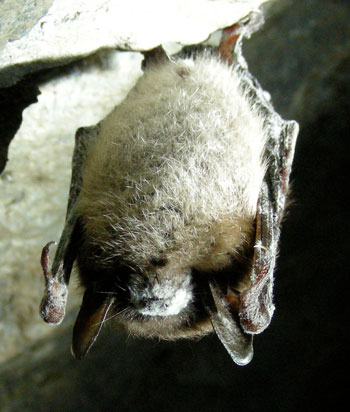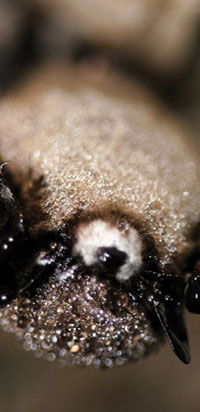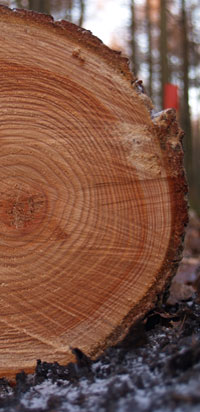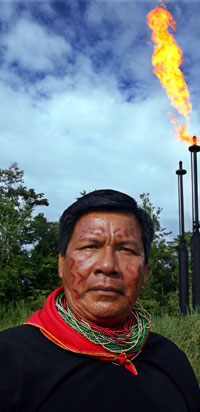
 White-nose syndrome has killed more than 1 million bats in North America in the past four years, and the fungus is spreading rapidly westward.
White-nose syndrome has killed more than 1 million bats in North America in the past four years, and the fungus is spreading rapidly westward.
Bats provide important — and valuable — pest control services in the environment. A recent study in Science magazine estimate those services are worth nearly $4 billion a year to American farmers. Now the U.S. Fish & Wildlife agency has released a plan to manage the disease, but scientists are still struggling to understand how it works.
White-nose syndrome is hitting North American bats hard, but some species are less vulnerable than others. A few even appear to be resistant to the disease. Biologists are trying to understand what gives some species, and some individuals, a better chance at surviving: maybe they have naturally occurring antifungal compounds on their skin, or maybe they hibernate in temperatures that aren't as friendly to the fungus. It's possible that such advantages could be conferred on less resistant bats.
I’ll be watching: The U.S. Fish and Wildlife Service issued a national white-nose syndrome plan last week, designed to improve coordination among the states, tribes, and federal agencies involved in studying and containing it. That's an important step, but funding is still scarce. Unlike bees, whose problems have gotten attention and support from the agriculture industry, bats don't have much of a constituency.
Notable quote: One scientist said to me, "If you can forget about how depressing it is for a minute, white-nose syndrome is incredibly fascinating." White-nose syndrome is taking a huge toll on North American wildlife, and that can't be minimized. But at the same time, scientists are amazed by how perfectly — some might say fiendishly — this fungus is able to take advantage of bat populations.
Click to read more about this topic
The disease is still being referred to as "white nose syndrome" as if that's the problem. In fact, that fuzzy residue isn't what's harming them, veterinary pathologists now say. It's the attack on wing tissue, where the fungus begins digesting the skin, then moves in to fill in the lost tissue with itself. This damage may be almost invisible, yet it eventually cuts into blood vessels, leading to the permanent death of tissue at downstream sites. In the end, the bats appear to die from dehydration as the wing tissue loses large amounts of moisture. Scientists have been trying to identify ways to treat the fungal infection. One biologist told me that after trying a number of therapies, "I'm not terribly hopeful."
I was surprised to learn … the fungus appears to not like warm environments, so its spread may be self-limited by climate.
Looking forward: The genome of the American version of the fungus has been sequenced. Scientists are currently studying the same fungus that is now hitting European bats — who aren’t dying. They suspect the American fungus has mutated to make it more deadly (to bats), and comparing the two genomes may identify the virulence factor in the American variant. But if they turn out to be exactly the same fungus, then American bats probably have some inherently vulnerability.
Click to read more about this topic
Scientists can’t say for certain that the fungus that causes white-nose syndrome is an invasive species, but there are strong indications that it is. People often think of invasive species as pushing aside “specialized” plants and animals that fill specific niches, but in this case, the fungus affects common bats, collectively numbering in the tens of millions! If an invasive fungus is at the root of this outbreak, I wonder about the resiliency of wildlife in an age where global trade and travel isn’t slowing down.
Going forward: Bats are incredibly efficient insect eaters, particularly of mosquitoes. So given the astonishing numbers of bats that have already died, I’ll be looking for the secondary affects of losing so much wildlife, such as insect outbreaks or forest infestations.
Notable quote: One of the lead scientists, Pat Ormsbee, said, “This is the worst wildlife crisis we have ever seen in modern wildlife history.... There has never been anything like this and we don’t know how to stop it.” My first reaction was to roll my eyes, but the statistics backed her up. In many of the affected caves, the loss of bats has been total: no more bats, nearly 100 percent die-off.
Click to read more about this topic
- Scientists Scramble to Understand Deadly 'White-Nose Syndrome' in Bats [By Ed Jahn, PBS Newshour]
- U.S. Fish and Wildlife Service Unveils Plan to Fight White-Nose Syndrome in Bats [By Louis Sahagun, Los Angeles Times]
- Plan Aims to Manage White-Nose Syndrome Across Borders [By Melanie J. Martin, Earth Times]
| Tweet This Page |












